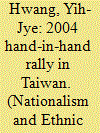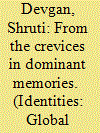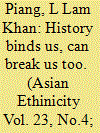| Srl | Item |
| 1 |
ID:
133960


|
|
|
|
|
| Publication |
2014.
|
| Summary/Abstract |
This article investigates how a collective memory of trauma was produced in the course of commemorating the 2-28 Incident in the context of the 2004 election campaign, and how this memory production led to the parallel formation of a Taiwanese national identity. The 2-28 Hand-in-Hand Rally was designed to remember the 2-28 Incident as a historical trauma in order to be forgotten. The remembering of the 2-28 Incident must be regarded as a constructive process as opposed to a retrieval process. The memory of the 2-28 Incident was selectively constituted in favor of sovereign power.
|
|
|
|
|
|
|
|
|
|
|
|
|
|
|
|
| 2 |
ID:
119388


|
|
|
|
|
| Publication |
2013.
|
| Summary/Abstract |
Dominant collective memories around the anti-Sikh violence of 1984 are mostly dichotomous. The official state memories of 1984 are replete with omissions about the attack on Sikhs and several human rights violations. On the other hand, the counter-mobilisations that developed in the aftermath of 1984 are largely focused on the demand for a separate state of Khalistan. I problematise these dichotomous framings by examining what I call present-day 'virtual commemorative crevices'. I suggest that these crevices are transnational, sacred or set-apart and liminal fissures in hegemonic memories and institutionalised forms of commemoration. I examine eight websites focusing on 1984 and the role of the Sikh diaspora in disrupting older temporal fixities and spatially rooted narratives. Virtual fissures mark a subtle, but significant shift from polarised hegemonic narratives to a more differentiated, future-oriented activism.
|
|
|
|
|
|
|
|
|
|
|
|
|
|
|
|
| 3 |
ID:
187159


|
|
|
|
|
| Summary/Abstract |
Monuments with inscriptions have always been an important source of history and are helpful for reconstructing the past. They recreate collective memories, as they were erected to commemorate significant events from the past. The historical process of state formation, especially among the former colonies, has bound different ethnic communities, which obliges them to initiate state nation-building processes. So, memories which are recreated, remembered, and forgotten have played a crucial role in shaping ethnic relations as well as relations between the state and various ethnic communities in a multi-ethnic state. This paper analyses the allegation about the Manipur’s Chibu stone inscription as a fabricated historical event, and the complaint asking that its status as a protected archaeological site be denied. It argues that in the name of the state nation-building project, the state has resorted to recreating collective memories with little consideration to the sentiment of ethnic minorities in a state.
|
|
|
|
|
|
|
|
|
|
|
|
|
|
|
|